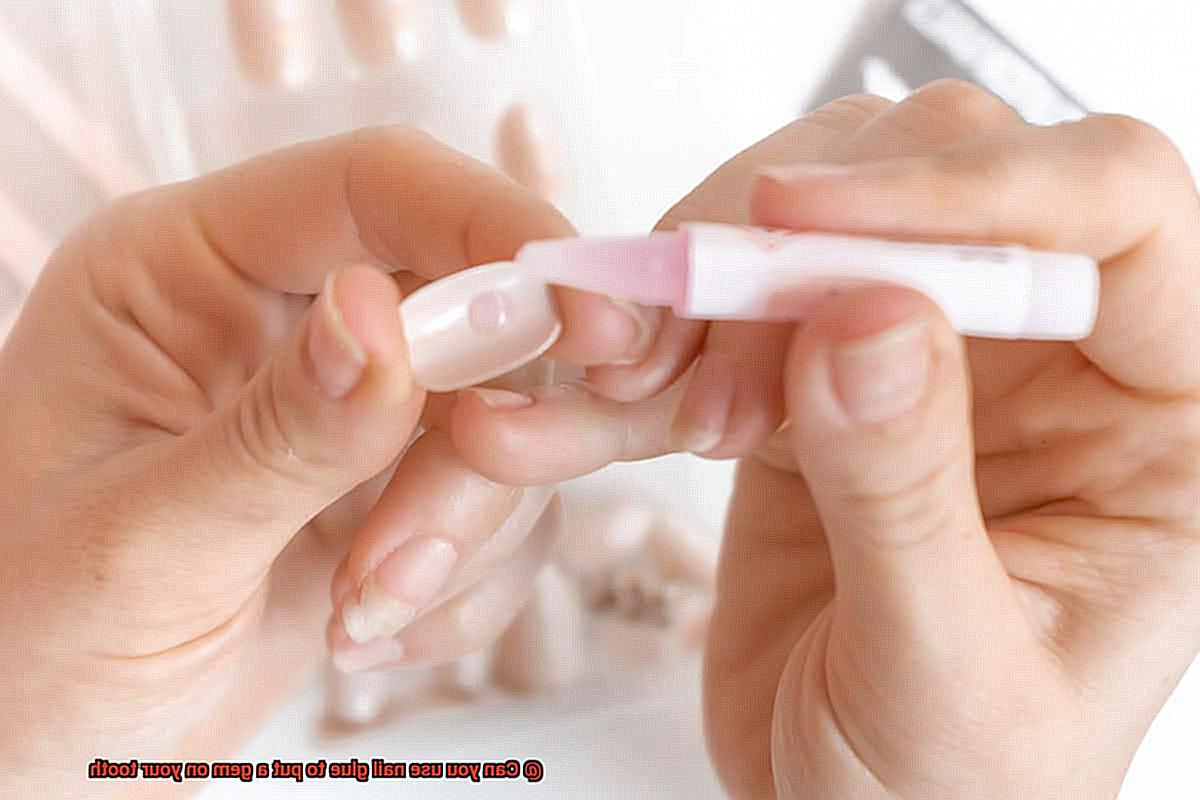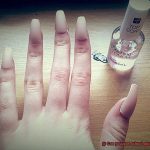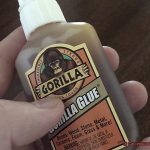In our never-ending quest for self-expression and style, we’re constantly on the lookout for unique ways to stand out from the crowd. From vibrant hair colors to bold fashion choices, we’re always seeking that extra touch of individuality. And now, a new trend is taking the beauty world by storm – tooth gems. These little sparklers are all about adding a dash of dazzle to your smile, turning heads wherever you go.
But here’s the burning question: can you use nail glue to secure these gems onto your pearly whites? As an expert in this field, I’m here to spill the tea and give you all the deets. So grab your favorite drink and get ready as we dive into this intriguing topic, exploring both the possibilities and potential pitfalls of using nail glue for tooth gem application.
Together, we’ll uncover safer alternatives, discuss any risks involved, and share essential tips for achieving that stunning smile you’ve been dreaming of. So buckle up and prepare for an enlightening journey through the fascinating world of tooth gem application – because your smile deserves nothing less than pure radiance.
What is Nail Glue?
Contents
It’s crucial to understand that nail glue has a specific purpose and should never be used on teeth. In this article, we will delve into the world of nail glue, its primary ingredients, and the reasons why it should stay far away from your pearly whites.
What is Nail Glue?
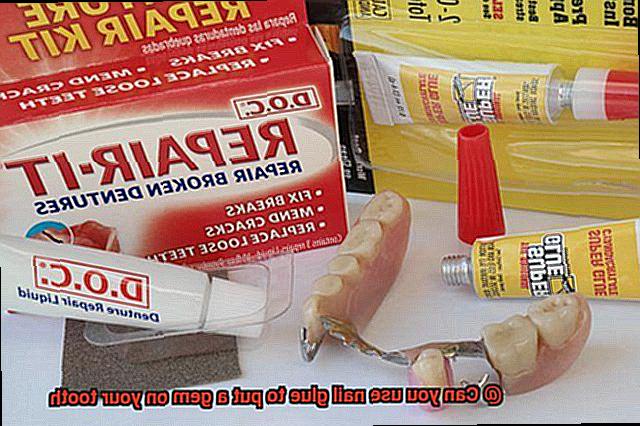
Nail glue is a specialized adhesive concocted with cyanoacrylate, a fast-drying wonder that forms an unbreakable bond when it comes into contact with moisture. This transparent superhero of adhesives allows nail artists to attach decorative elements like gems, rhinestones, and charms to their nails with precision and flair.
Why Not on Teeth?
Using nail glue on teeth is a recipe for disaster, and here’s why:
- Toxicity: Nail glue contains chemicals like ethyl cyanoacrylate that are not meant for oral use. If ingested or in contact with the oral cavity, these substances can cause irritation, burns, or other adverse reactions.
- Durability: Unlike nails, the oral environment is constantly in contact with saliva, which can compromise the adhesive properties of nail glue. This means that any gem or decorative element attached to a tooth may not stay firmly in place and could easily come loose or worse – fall off.
- Potential Damage: Removing a gem attached with nail glue from a tooth may require scraping or using solvents, which can lead to enamel damage, tooth sensitivity, or even fractures.
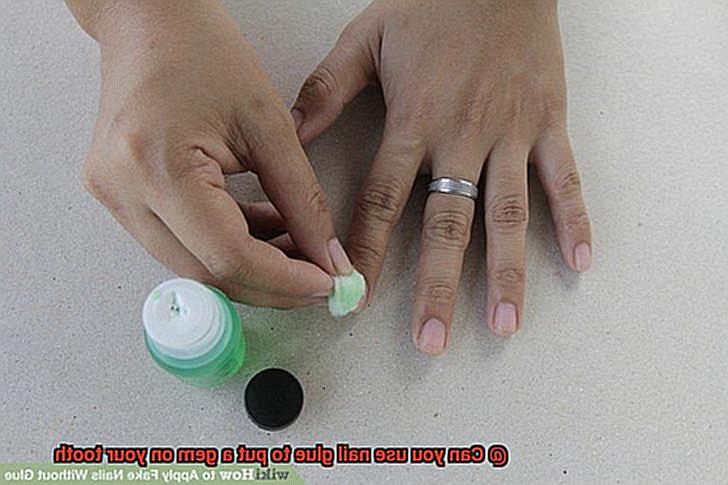
Alternatives for Dental Decorations:
If you’re yearning for dental bling, it’s best to consult a dental professional who can provide safe alternatives specifically designed for oral use. Options like dental bonding agents or adhesives formulated for the mouth are available and can be applied and removed without causing any harm to your precious teeth.
Is Nail Glue Safe for Oral Use?
When it comes to oral health, using safe products is crucial. One popular trend that has emerged is attaching gems or accessories to the teeth. While it may be tempting to use nail glue for this purpose, it’s important to understand why nail glue is not safe for oral use and explore alternative options that can protect your pearly whites.
Nail glue’s intended use:
Nail glue is specifically formulated for adhering artificial nails to natural nails or fixing broken or split natural nails. It is not designed or intended for use in the mouth. Using it on your teeth or gums can have adverse effects.
Chemical composition:
Nail glue contains chemicals like cyanoacrylate, which may pose health risks if ingested or have prolonged contact with delicate oral tissues. These chemicals have not been tested or approved by regulatory bodies, such as the FDA, for oral use. It’s essential to avoid exposing your mouth to potentially harmful substances.
Potential risks and complications:
Applying nail glue on your teeth or gums can lead to irritation, inflammation, and damage to the sensitive tissues in your mouth. Additionally, the strong adhesive properties of nail glue can make gem removal difficult without causing harm. Protecting your oral health should be a top priority.
Lack of safety standards:
Since nail glue is not intended for oral use, there are no established safety standards or guidelines for its application in the mouth. It’s always best to prioritize oral health and consult a dental professional before using any foreign substances on your teeth.
Safe alternatives:
Fortunately, there are dental adhesives specifically designed for oral use that are safer and more appropriate for attaching gems or accessories to your teeth. These products are non-toxic, easy to remove, and gentle on both your teeth and gums. By using these dental adhesives, you can ensure the safety and well-being of your oral cavity.
How Does Nail Glue React in the Mouth?

Get ready to discover why nail glue is a big no-no when it comes to attaching gems to your teeth. Let’s dive into the fascinating reaction that nail glue has in the mouth and explore safer alternatives for dazzling your smile.
The Power of Cyanoacrylate:
Let’s begin with the star ingredient of nail glue – cyanoacrylate. This potent adhesive is designed to bond quickly and securely. When nail glue encounters moisture, it undergoes a chemical reaction known as polymerization, transforming from a liquid into a solid within seconds.
The Mouth is Not the Place:
While nail glue can work wonders for nails, it should never be used in the mouth. Why? Well, our saliva contains an abundance of moisture, and when nail glue meets it, it hardens rapidly. This rapid hardening can lead to discomfort, irritation, and potential damage to delicate oral tissues.
Toxic Ingredients:
Did you know that nail glues often contain additional ingredients like ethyl cyanoacrylate or formaldehyde? These substances are not safe for oral use and can have adverse effects if swallowed or applied internally. Ingesting them can cause unpleasant symptoms such as nausea, vomiting, and abdominal pain.
Oral Health Hazards:
Using nail glue in the mouth can create a host of problems. The hardened glue may interfere with proper speech and chewing, causing significant discomfort. Additionally, it can become a breeding ground for harmful bacteria, leading to oral infections and other dental issues. Loose or dislodged gems attached with nail glue can also pose a choking hazard.
Safe Alternatives:
To protect your pearly whites while still adding some sparkle, consult a dental professional for safe alternatives. Dental adhesives specifically designed for oral use are gentle, safe, and ensure your oral health remains uncompromised. Your dentist will guide you through the options that will keep your smile shining bright.
Potential Damage from Removing a Gem Attached with Nail Glue
When it comes to adding a touch of sparkle to your smile, attaching gems with nail glue may seem like a tempting idea. However, before you dive into bedazzling your teeth, it’s important to understand the potential damage that can occur when attempting to remove a gem attached with nail glue. Let’s explore the risks in more detail.
- Enamel Damage: Nail glue is specifically designed to adhere to natural nails, not tooth enamel. The chemical composition of nail glue may not be suitable for bonding with the hardest substance in the human body – tooth enamel. When trying to remove a gem attached with nail glue, you run the risk of damaging your enamel. This can lead to chipped or eroded teeth, which certainly won’t give you the dazzling smile you were hoping for.
- Difficult Removal: The bond formed by nail glue can be incredibly strong, especially if it has seeped into any crevices or gaps on your tooth surface. This means that removing the gem can be quite challenging. Applying forceful removal techniques like prying or pulling can result in enamel erosion or worse, a chipped tooth. It’s essential to exercise caution and seek professional help to avoid these potential pitfalls.
- Irritation and Allergic Reactions: Nail glue often contains harsh chemicals that are not meant to come into contact with oral tissues. These chemicals can irritate your gums, tongue, and other soft tissues in your mouth. Prolonged exposure can lead to inflammation, discomfort, or even allergic reactions. A sparkling tooth is certainly not worth enduring an inflamed and uncomfortable mouth.
- Damage to Surrounding Teeth and Oral Structures: The pressure applied during the removal process can also pose risks to the surrounding teeth and oral structures. Mishandling or using improper techniques may result in chipped or fractured teeth, requiring additional dental treatment to repair the damage. It’s crucial to prioritize the health and integrity of your entire oral cavity when considering cosmetic modifications.
- Choking Hazard and Respiratory Injury: Lastly, there’s the potential risk of the gem itself coming loose while eating or performing oral hygiene routines. If the gem becomes dislodged, you could accidentally swallow it or, even worse, inhale it. This poses a significant choking hazard or can cause injury to your respiratory system. Needless to say, these potential consequences are far from desirable.
Alternatives to Using Nail Glue on Teeth
While the thought of using nail glue and gems on your teeth might be tempting, it’s important to consider the potential risks involved. Luckily, there are safer alternatives available that can still give you the dazzling smile you desire. In this article, we will explore the top alternatives to using nail glue on teeth, ensuring a safe and hassle-free experience.
Dental Bonding:
Dental bonding is a popular alternative performed by a dentist. This cosmetic procedure involves applying a tooth-colored resin material to the tooth surface and bonding it with a special curing light. The resin can be shaped and molded to accommodate gems or decorations, providing a safe and long-lasting attachment.
Dental Adhesives:
Specifically formulated for temporary dental attachments, dental adhesives are a safe option. These adhesives are designed for use in the mouth and can be easily removed without causing any damage to your teeth. Simply apply a small amount of adhesive to the gem or decoration, press it onto your tooth, and enjoy your new smile enhancement.
Dental Wax:
Another safe and easy-to-use alternative is dental wax. This soft and malleable material can be shaped and placed over the tooth surface, creating a temporary bond. Dental wax is gentle on your teeth and can be removed without any harm or discomfort.
Consult with a Dentist:
Before attempting any dental modifications, it’s crucial to seek professional advice from a dentist. They will assess your specific dental needs and provide guidance on the safest and most suitable method for attaching gems or decorations to your teeth.
Dental Bonding Agents and Adhesives for Oral Use
While the idea of attaching a gem to your tooth with nail glue may seem tempting, it’s important to understand that this is not a safe or recommended option. Nail glue is specifically designed for use on nails, not teeth, and can be harmful if ingested or come into contact with oral tissues. So, what are the better alternatives for oral use? Let’s dive into the world of dental bonding agents and adhesives.
Dental bonding agents and adhesives are specially formulated materials used in dentistry to bond various dental restorations to the teeth. These materials have undergone rigorous testing for safety and efficacy, making them the ideal choice for oral use.
There are different types of dental bonding agents and adhesives available, each with its own unique properties and applications. Let’s explore some of them:
- Resin-based adhesives: These consist of a resin component and an activator or catalyst. When these components are mixed together, a chemical reaction occurs, resulting in a strong bond between the restoration and the tooth structure. Resin-based adhesives are widely used due to their durability and strength.
- Self-etching adhesives: These contain a mild acid that etches the tooth surface while simultaneously priming and bonding to the tooth structure. This eliminates the need for separate etching and priming steps, making the bonding process more efficient.
- Glass ionomer cements: These are made up of a glass powder and a liquid that contains an acidic component. When these components are mixed together, a chemical reaction occurs, forming a hardened cement that provides a strong bond.
Now that we know about the different types of dental bonding agents and adhesives, it’s crucial to understand why using nail glue on your teeth is not recommended. Nail glue is not designed for oral use and can contain ingredients that are harmful if ingested or come into contact with oral tissues. Additionally, nail glue may not provide a strong and durable bond between the gem and the tooth.
So, what are the better alternatives for adding decorative elements to your teeth? The best course of action is to consult with a dental professional. They have access to dental adhesives specifically designed for oral use, ensuring a strong and long-lasting bond between the decoration and your tooth.
U0cKOHO_6jE” >
Conclusion
In conclusion, using nail glue to secure a gem onto your tooth is not only unsafe but also highly discouraged. Nail glue is specifically formulated for nails and contains chemicals that are not intended for oral use. This means that using it on your teeth can pose potential risks and complications that you definitely want to avoid.
Toxicity is one major concern when it comes to using nail glue on teeth. The chemicals in the glue could be harmful if ingested or come into contact with your gums and other oral tissues. Additionally, nail glue may not hold up well in the moist environment of your mouth, leading to durability issues and the gem falling off unexpectedly.
Moreover, applying nail glue to your tooth can potentially damage the enamel, which is the protective outer layer of your teeth. Damaging the enamel can make your tooth more susceptible to cavities, sensitivity, and other dental problems.
Instead of taking such risks, it is always best to consult a dental professional who can offer safer alternatives designed specifically for oral use. Dental bonding agents, dental adhesives, and dental wax are all viable options for attaching gems or decorations to your teeth without compromising your oral health.
Dental bonding involves applying a tooth-colored resin material onto the tooth surface and curing it with a special light. Dental adhesives are specially formulated for temporary dental attachments and can be easily removed without causing any damage. As for dental wax, it provides a safe alternative that can be shaped and placed over the tooth surface.
Your oral health should always be a top priority when considering any modifications to your teeth. Seeking professional advice from a dentist will ensure that you choose the safest and most suitable method for attaching gems or decorations while maintaining optimal oral health.

